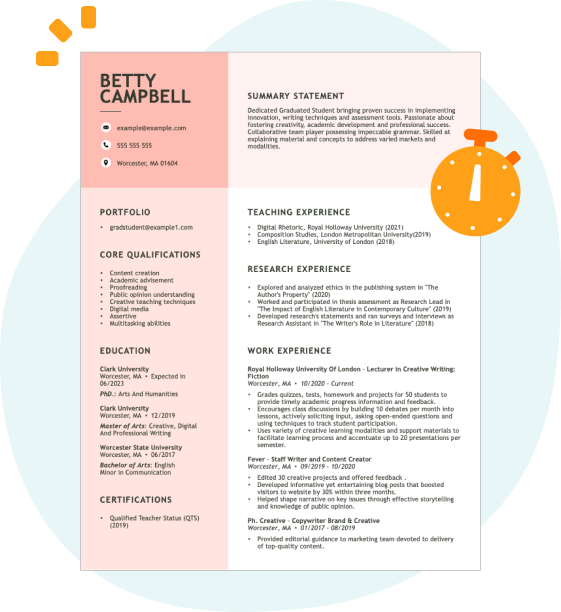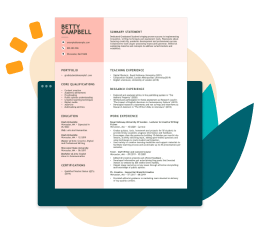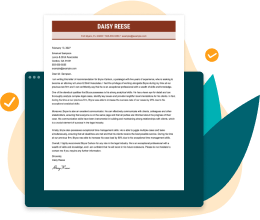Technical abilities such as personal care tasks, medication management, and basic life support are hard skills that caregivers must master to ensure patient safety and well-being.
Popular Caregiver Resume Examples
Check out our top caregiver resume examples that demonstrate key skills such as compassion, attention to detail, and effective communication. These examples can help you showcase your experience in a way that resonates with potential employers.
Ready to build your perfect resume? Our Resume Builder offers user-friendly templates designed specifically for caregivers, making it simple to highlight your unique qualifications.
Entry-level caregiver resume
This entry-level resume for a caregiver effectively highlights the job seeker's hands-on experience in providing compassionate care and improving client satisfaction through measurable outcomes. New professionals in this field must demonstrate their ability to coordinate healthcare, engage with clients, and showcase relevant certifications or training, even when lacking extensive work history.
Mid-career caregiver resume
This resume effectively showcases qualifications by detailing extensive experience in caregiving and leadership roles. The clear presentation of skills and accomplishments illustrates the job seeker's readiness for increased responsibilities, highlighting a strong commitment to client wellness and professional development.
Experienced caregiver resume
This work experience section showcases the applicant's extensive experience as a caregiver, demonstrating their ability to manage medication and improve client satisfaction by 30%. The use of bullet points improves readability, making it easy for employers to quickly identify key achievements.
Resume Template—Easy to Copy & Paste
Jane Williams
Indianapolis, IN 46205
(555)555-5555
Jane.Williams@example.com
Professional Summary
Dedicated Caregiver with 6 years of experience in improving client satisfaction and facilitating a safe and supportive environment. Proficient in medication administration, patient monitoring, and therapeutic activity planning. Committed to enhancing client independence and welfare through empathetic and communicative care.
Work History
Caregiver
CareWell Home Services - Indianapolis, IN
January 2024 - October 2025
- Improved client satisfaction by 30%
- Managed schedules for 10+ clients
- Assisted with ADLs, boosting client independence
Home Health Aide
BrightPath Caregiving - Greenfield, IN
January 2022 - December 2023
- Reduced emergency visits by 15%
- Provided daily care to 8 patients
- Administered medications, improving adherence
Personal Support Worker
Serenity Care Solutions - Indianapolis, IN
January 2019 - December 2021
- Enhanced mobility support for 5+ clients
- Conducted 100+ health check routines
- Organized therapeutic activities weekly
Languages
- Spanish - Bilingual or Proficient (C2)
- French - Beginner (A1)
- Italian - Beginner (A1)
Skills
- Patient Care
- Medication Administration
- Communicative Skills
- Empathy and Compassion
- Time Management
- Critical Thinking
- Health Monitoring
- Therapeutic Activity Organization
Certifications
- Certified Nursing Assistant - American Red Cross
- CPR and First Aid - American Heart Association
Education
Master's Degree Social Work
University of California, Los Angeles Los Angeles, California
June 2018
Bachelor's Degree Psychology
California State University, Fullerton Fullerton, California
June 2016
How to Write a Caregiver Resume Summary
Your resume summary is the first impression employers have of you, so it’s important to make it effective. This section should highlight your unique qualifications and experiences that set you apart as a caregiver.
As a caregiver, focus on showcasing your compassion, communication skills, and relevant experience in providing support for individuals in need. Employers want to see how your background aligns with their expectations for this role.
To help illustrate effective strategies for writing your summary, the following examples will clarify what captures attention and what may fall short:
Weak resume summary
I am a dedicated caregiver with several years of experience in various settings. I seek a position where I can use my skills and help improve the lives of others. A supportive team environment that values compassion and teamwork is important to me. I believe I can contribute positively if given the chance.
- Lacks specific details about the job seeker's skills and accomplishments, making it vague
- Overuses personal pronouns and general statements that don’t highlight unique qualities
- Emphasizes what the applicant hopes to gain rather than outlining their value to potential employers
Strong resume summary
Compassionate caregiver with over 6 years of experience providing personalized support to elderly and disabled individuals. Successfully improved clients' quality of life by implementing tailored care plans, leading to a 20% increase in client satisfaction scores. Proficient in medical assistance, mobility support, and maintaining accurate health records.
- Begins with clear indication of experience level and caregiving focus
- Highlights a quantifiable achievement that illustrates the positive impact on client well-being
- Showcases relevant skills that align with the demands of caregiving positions
PRO TIP
Showcasing Your Work Experience
The work experience section is the cornerstone of your resume as a caregiver. This area will contain the majority of your content, and good resume templates always emphasize its importance.
Organize it in reverse-chronological order, listing your previous positions clearly. Use bullet points to highlight specific achievements and the impact you made in each caregiving role.
To assist you further, we’ve prepared a couple of examples that illustrate effective ways to present your work history as a caregiver. These examples will clarify what works well and what doesn’t:
Caregiver
Sunrise Senior Living – Phoenix, AZ
- Helped residents with daily activities.
- Maintained a clean and safe environment.
- Assisted with meal preparation and feeding.
- Provided companionship to seniors.
- Lacks specific employment dates
- Bullet points are overly simplistic and fail to highlight unique skills or contributions
- Describes routine tasks instead of showcasing effective results or improvements made
Caregiver
Sunshine Assisted Living – Orlando, FL
March 2020 - Current
- Assist residents with daily living activities, improving their independence and quality of life.
- Implement engaging activities that promote social interaction, resulting in a 30% increase in resident satisfaction scores.
- Maintain detailed records of patient progress and communicate changes to healthcare teams to ensure timely interventions.
- Uses strong action verbs to clearly state the caregiver’s responsibilities and achievements
- Incorporates specific metrics, like satisfaction scores, to quantify success
- Highlights relevant skills such as communication and record-keeping that are essential for effective caregiving
While your resume summary and work experience are important components, don’t overlook the other sections that play a key role in showcasing your qualifications. For more detailed guidance on structuring your resume effectively, explore how to write a resume for a comprehensive guide.
Top Skills to Include on Your Resume
A skills section is important to your resume, offering a snapshot of your abilities and helping employers quickly determine if you meet the job requirements.
Showcasing a blend of hard and soft skills on your resume will make your application more competitive.
Interpersonal qualities like patience, empathy, and effective communication are considered soft skills, which foster trust and improve collaboration between caregivers and patients.
Selecting the right resume skills is important as it aligns your qualifications with what employers expect from job seekers. Many organizations implement automated screening systems to filter out applicants lacking essential skills for the role.
To effectively highlight your skills, review job postings closely. Job listings often reveal which abilities are most valued, helping you tailor your resume to stand out to both recruiters and ATS systems alike.
PRO TIP
10 skills that appear on successful caregiver resumes
Improve your resume to attract recruiters by highlighting essential skills tailored for caregiver roles. These in-demand abilities are showcased in our resume examples, giving you the confidence to apply effectively.
Here are 10 skills you should consider including in your resume if they fit your qualifications and role requirements:
Dependable and responsible
49%
Elderly care
48%
Medication administration
44%
Patient assessments
42%
Meal preparation
39%
Time management
37%
Dementia care
37%
First aid and safety
35%
Problem-solving
33%
Multitasking and organization
31%
Based on analysis of 5,000+ child care professional resumes from 2023-2024
Resume Format Examples
Selecting the appropriate resume format is important for caregivers as it showcases your most relevant experience and skills, illustrating your growth and suitability for the role.
Functional
Focuses on skills rather than previous jobs
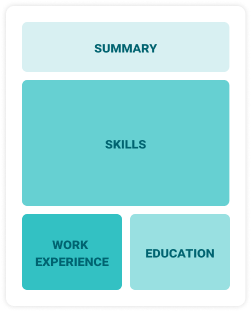
Best for:
Recent graduates and career changers with limited experience in caregiving
Combination
Balances skills and work history equally
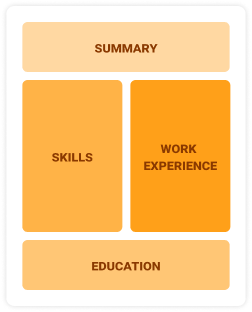
Best for:
Mid-career professionals focused on demonstrating their skills and growth potential
Chronological
Emphasizes work history in reverse order
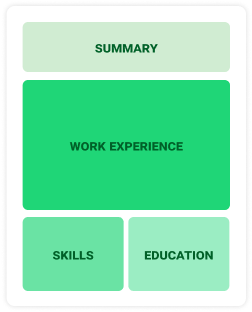
Best for:
Senior caregivers excelling in complex care management or team leadership
Frequently Asked Questions
Should I include a cover letter with my caregiver resume?
Absolutely. Including a cover letter can make a significant difference in your job application by highlighting your relevant skills and demonstrating your enthusiasm for the position. If you’re looking for assistance, check out our comprehensive guide on how to write a cover letter. Alternatively, you can use our Cover Letter Generator to create one quickly and easily.
Can I use a resume if I’m applying internationally, or do I need a CV?
When applying for jobs outside the U.S., use a CV instead of a resume. A CV provides a comprehensive overview of your professional history and is often required in many countries. Explore CV examples and detailed guides to learn how to write a CV effectively.
What soft skills are important for caregivers?
Soft skills such as patience, empathy, and effective communication are essential for caregivers. These interpersonal skills foster trust and understanding with those in their care, enabling caregivers to provide support that improves the well-being of individuals while promoting a collaborative environment among colleagues.
I’m transitioning from another field. How should I highlight my experience?
Highlight your transferable skills, such as communication, empathy, and organization. These abilities showcase your readiness to excel in caregiving roles despite minimal direct experience. Share specific instances from previous jobs that illustrate how these strengths can improve patient interactions and support team dynamics effectively.
Where can I find inspiration for writing my cover letter as a caregiver?
For those applying for caregiver roles, exploring professional cover letter examples can be incredibly beneficial. These samples offer valuable content ideas and formatting tips to help you effectively showcase your qualifications and personal story in a compelling way.
How do I write a resume with no experience?
If you're looking for a resume with no experience as a caregiver, focus on your volunteer work, caregiving for family or friends, and any relevant certifications. Highlight your compassion, patience, and communication skills. Employers appreciate dedication and a genuine desire to assist others. Your unique experiences can differentiate you and demonstrate your potential to thrive in this role.


